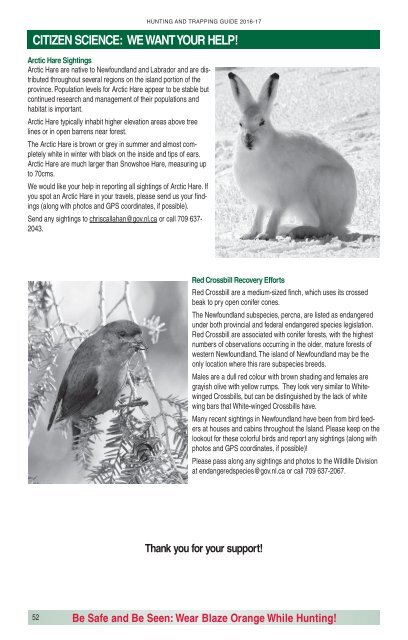Hunting & Trapping
2cjuBGz
2cjuBGz
Create successful ePaper yourself
Turn your PDF publications into a flip-book with our unique Google optimized e-Paper software.
HUNTING AND TRAPPING GUIDE 2016-17<br />
CITIZEN SCIENCE: WE WANT YOUR HELP!<br />
Arctic Hare Sightings<br />
Arctic Hare are native to Newfoundland and Labrador and are distributed<br />
throughout several regions on the island portion of the<br />
province. Population levels for Arctic Hare appear to be stable but<br />
continued research and management of their populations and<br />
habitat is important.<br />
Arctic Hare typically inhabit higher elevation areas above tree<br />
lines or in open barrens near forest.<br />
The Arctic Hare is brown or grey in summer and almost completely<br />
white in winter with black on the inside and tips of ears.<br />
Arctic Hare are much larger than Snowshoe Hare, measuring up<br />
to 70cms.<br />
We would like your help in reporting all sightings of Arctic Hare. If<br />
you spot an Arctic Hare in your travels, please send us your findings<br />
(along with photos and GPS coordinates, if possible).<br />
Send any sightings to chriscallahan@gov.nl.ca or call 709 637-<br />
2043.<br />
Red Crossbill Recovery Efforts<br />
Red Crossbill are a medium-sized finch, which uses its crossed<br />
beak to pry open conifer cones.<br />
The Newfoundland subspecies, percna, are listed as endangered<br />
under both provincial and federal endangered species legislation.<br />
Red Crossbill are associated with conifer forests, with the highest<br />
numbers of observations occurring in the older, mature forests of<br />
western Newfoundland. The island of Newfoundland may be the<br />
only location where this rare subspecies breeds.<br />
Males are a dull red colour with brown shading and females are<br />
grayish olive with yellow rumps. They look very similar to Whitewinged<br />
Crossbills, but can be distinguished by the lack of white<br />
wing bars that White-winged Crossbills have.<br />
Many recent sightings in Newfoundland have been from bird feeders<br />
at houses and cabins throughout the Island. Please keep on the<br />
lookout for these colorful birds and report any sightings (along with<br />
photos and GPS coordinates, if possible)!<br />
Please pass along any sightings and photos to the Wildlife Division<br />
at endangeredspecies@gov.nl.ca or call 709 637-2067.<br />
Thank you for your support!<br />
52<br />
Be Safe and Be Seen: Wear Blaze Orange While <strong>Hunting</strong>!


